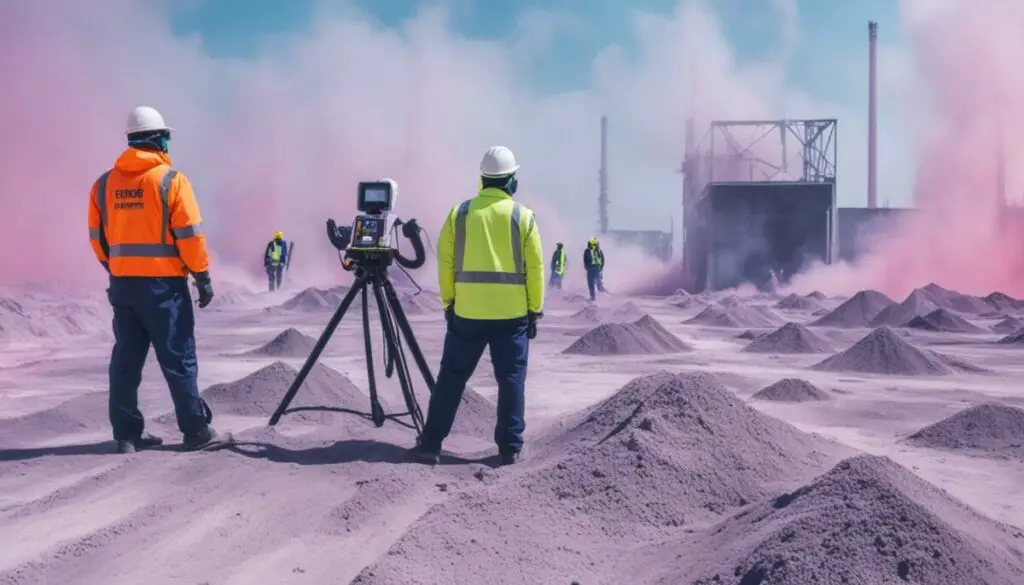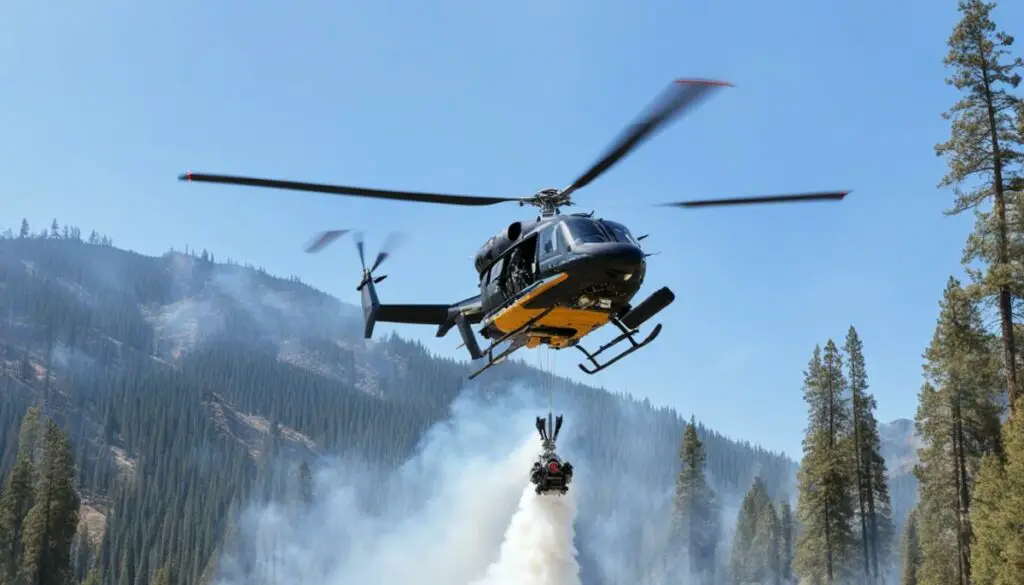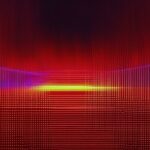Last Updated on 4 months by Francis
Dust particles are often challenging to detect using visible light or infrared imagery due to their low optical density and resemblance to other types of clouds. However, advancements in RGB imaging techniques have made it possible to enhance the visibility of dust particles using infrared imagery. By utilizing band differencing and the thermal channel in infrared imaging, dust storms can now be observed during both daytime and nighttime. Dust appears as pink or magenta during the day and may change color at night based on its height. Furthermore, infrared imaging helps distinguish dust from land surfaces like deserts and oceans, providing valuable information about cloud height, phase, and thickness.
Contents
Key Takeaways:
- Dust particles are difficult to detect using visible light or infrared imagery alone.
- Advanced RGB imaging techniques enhance the visibility of dust particles using infrared imagery.
- Dust appears pink or magenta during the day and changes color at night depending on its height.
- Infrared imaging helps distinguish dust from land surfaces and provides information about cloud height, phase, and thickness.
- RGB imaging and infrared detection are valuable tools in various fields including meteorology, aviation, and emergency response.
What is the Dust RGB Imagery and How Does It Work?

The Dust RGB (Red-Green-Blue) imagery is a powerful technique used to differentiate between airborne dust, clouds, and other surfaces. By combining different color bands and their respective differences, this specialized imagery enhances the visibility of dust particles in a unique way.
The recipe for Dust RGB imagery involves analyzing three color bands: red, green, and blue. Each band provides valuable information about different aspects of the observed scene, contributing to the identification and characterization of dust particles.
The red band in the Dust RGB imagery represents optical depth or cloud thickness. Thin clouds appear as lighter shades, while thicker dust clouds or dense aerosol plumes exhibit darker shades. This allows imagery analysts to easily distinguish between different cloud types and identify areas with higher concentrations of dust particles.
The green band is utilized to indicate the particle phase. Ice particles and uniform-shaped particles, such as dust, appear as shades of green. In contrast, water particles or thin cirrus clouds over deserts manifest differently, aiding in the differentiation of dust from other cloud types and surfaces.
The blue band, on the other hand, represents surface temperature. Cold surfaces appear as darker shades, while warmer surfaces appear as lighter shades. This temperature contrast allows analysts to identify areas where dust is present and distinguish them from surrounding surfaces.
By analyzing the colors and their contributions to each pixel, dust plumes can be easily identified from surrounding clouds, both during the day and night. This technique, combined with infrared band differencing, enables accurate detection and characterization of dust particles.
The Dust RGB imagery technique, with its specialized recipe and analysis of different color bands, provides enhanced visibility of dust particles in various environmental conditions.
To provide a visual representation of the Dust RGB imagery process, refer to the example table below:
| Color Band | Information Represented | Visual Appearance |
|---|---|---|
| Red | Optical depth or cloud thickness | Thin clouds – lighter shades Thick clouds/dust – darker shades |
| Green | Particle phase | Ice/dust – shades of green Water/thin cirrus over deserts – different appearance |
| Blue | Surface temperature | Cold surfaces – darker shades Warm surfaces – lighter shades |
With the Dust RGB imagery technique, detecting and distinguishing dust particles from other cloud types and surfaces becomes feasible. By leveraging the combination of different color bands and their unique contributions, analysts can gain valuable insights into the distribution, concentration, and characteristics of airborne dust.
Limitations and Impact on Operations

While dust RGB imagery is a valuable tool for dust detection, it does have certain limitations that can impact operational effectiveness.
Limitation 1: Determining Dust Thickness
One of the limitations of dust RGB imagery is its inability to directly determine the thickness of dust plumes. The variations in color during the day only indicate density and not the actual thickness of the dust. However, it is worth noting that very thick dust plumes may appear purple in both day and night scenes.
Limitation 2: Low Clouds Over Oceans
Another limitation is that low clouds over oceans can sometimes look similar to dust, particularly at night. This similarity can pose challenges in accurately differentiating between low clouds and dust using dust RGB imagery.
Limitation 3: High Clouds Obscuring Dust
Additionally, high cloud cover can obscure dust plumes that are beneath them. This can make spatial analysis more challenging as the dust particles may not be clearly visible, impacting the detection and tracking of dust using the RGB imagery technique.
Despite these limitations, the use of dust RGB imagery can greatly assist in identifying dust particles and provide valuable information for various operations:
- Cloud Height/Type Analysis
- Determining Air Mass/Moisture Boundaries
- Detecting Volcanic Ash
| Limitations of Dust RGB | Impact on Operations |
|---|---|
| Inability to determine dust thickness | Challenges in assessing the severity of dust storms |
| Similar appearance to low clouds over oceans | Possible misinterpretation of dust presence |
| Obscurement of dust plumes by high clouds | Difficulty in spatial analysis and tracking dust |
The Role of SWIR Sensors in Dust Detection

Dust detection can be a challenging task, especially in poor visibility conditions caused by atmospheric haze, moisture, or dust. However, Short-Wave Infrared (SWIR) sensors offer a powerful solution to this problem. Operating in the 1-3 micron waveband, SWIR sensors possess a unique ability to penetrate through atmospheric haze, making them highly effective in detecting dust particles. Unlike Medium-Wave IR (MWIR) sensors, which excel at night vision, and Long-Wave IR (LWIR) sensors, which are used for thermal imaging, SWIR sensors provide exceptional visibility through poor atmospheric conditions.
When combined with Artificial Intelligence (AI) and Machine Learning technology like ViDAR (Visual Detection and Ranging), SWIR sensors become even more powerful. They can not only detect but also track targets that are otherwise invisible to the human eye or difficult to spot using other imaging techniques. By leveraging SWIR technology, operators can detect small objects in challenging environments, greatly enhancing their ability to detect targets from greater distances.
There are numerous benefits to using SWIR sensors in dust detection. These sensors enable operators to see through atmospheric haze, ensuring better visibility and enhancing situational awareness. The ability to detect and track targets in hazy conditions is particularly advantageous in aviation, maritime patrol, and search and rescue operations. SWIR sensors equipped with ViDAR technology provide unparalleled capabilities for detecting and tracking targets, making them an invaluable tool in various operational scenarios.
Benefits of SWIR Sensors:
- Ability to penetrate atmospheric haze caused by moisture, dust, or smoke
- Enhanced visibility in poor visibility conditions
- Detection of targets that are invisible to the human eye
- Tracking of targets in challenging environments
- Improved range for target detection
| Advantages | Applications |
|---|---|
| Enhanced visibility in poor atmospheric conditions | Aviation |
| Improved target detection range | Maritime Patrol |
| Tracking of targets in challenging environments | Search and Rescue |
Applications and Advantages of SWIR and ViDAR Technology

SWIR and ViDAR technology offer a wide range of applications and advantages, making them valuable tools in various fields. Whether it’s maritime patrol, law enforcement, search and rescue operations, or land-based activities, SWIR and ViDAR equipped systems provide operators with enhanced capabilities to detect and track targets in challenging optical environments.
In maritime patrol, SWIR sensors play a crucial role in detecting targets in hazy conditions, improving visibility and target tracking. This capability is particularly beneficial when it comes to identifying vessels such as terrorists’ boats or illegal fishers’, allowing for prompt action and better maritime security.
SWIR/ViDAR-equipped aircraft or UAVs offer exceptional advantages in maintaining overwatch of friendly forces from a safe altitude, even in the presence of smoke or dust. This ensures continuous situational awareness and enables timely response to emerging threats or changing circumstances.
“SWIR and ViDAR technology have revolutionized the way we conduct maritime operations. With their ability to see through haze and other challenging conditions, these systems have greatly enhanced our situational awareness and overall effectiveness.” – Captain Claire Thompson, Maritime Patrol Officer
In land-based operations, SWIR and ViDAR technology prove invaluable in detecting targets in polluted or dusty areas. By penetrating through atmospheric haze, these systems provide operators with enhanced situational awareness and allow for effective target tracking, which is crucial in scenarios such as law enforcement, border control, and search and rescue missions.
Advantages of SWIR and ViDAR Technology:
- Improved visibility and target detection in hazy conditions
- Enhanced situational awareness for operators
- Extended range of target detection, even in challenging optical environments
- Real-time monitoring and tracking capabilities
- Passive and productive detection capability
SWIR and ViDAR provide operators with unparalleled advantages, ensuring better decision-making and response capabilities, regardless of the environmental challenges they may face.
| Applications | Advantages |
|---|---|
| Maritime Patrol | Enhanced visibility in hazy conditions Detection of targets at longer ranges |
| Law Enforcement | Better situational awareness in land-based operations Improved detection of targets in polluted or dusty areas |
| Search and Rescue | Swift detection and tracking of targets, even in challenging optical environments |
SWIR and ViDAR are paving the way for cutting-edge technologies that greatly enhance target detection and tracking capabilities across various domains. As further developments and advancements occur, we can anticipate even broader applications and more seamless integration of these technologies in the future.
SWIR and ViDAR in Aviation and Emergency Response

SWIR (Short-Wave Infrared) and ViDAR (Visual Detection and Ranging) technology play a crucial role in aviation and emergency response scenarios. These advanced technologies offer significant advantages in detecting targets from greater distances and have diverse applications in emergency situations.
In aviation, SWIR sensors provide extended target detection range, even in challenging environments such as haze or smoke. This capability enhances operational safety by providing operators with more time to react and make informed decisions. With SWIR technology, pilots can identify potential hazards and take necessary actions promptly, minimizing risks.
In emergency response scenarios, particularly during firefighting operations, SWIR and ViDAR-equipped unmanned aerial vehicles (UAVs) offer invaluable benefits. These UAVs can operate at a safe stand-off altitude while providing critical visual information about the flame front and the location of essential assets like fire trucks. By utilizing SWIR and ViDAR, emergency responders and managers gain improved situational awareness, enabling them to effectively plan and manage the response to the emergency.
SWIR sensors enable safer operations in aviation by extending target detection range in challenging environments, while ViDAR-equipped UAVs enhance situational awareness and aid emergency response in critical situations – making a significant difference in both fields.
The combination of SWIR and ViDAR technologies empowers aviation professionals and emergency response teams to overcome visibility limitations and make informed decisions rapidly. SWIR technology enables enhanced target detection, even in hazy or smoky conditions, ensuring the safety of operations. Meanwhile, ViDAR, with its visual detection and ranging capabilities, provides crucial on-the-ground situational awareness, facilitating effective emergency response management.
Benefits of SWIR and ViDAR in Aviation and Emergency Response
The integration of SWIR and ViDAR technology in aviation and emergency response offers a range of benefits:
- Enhanced target detection range, even in challenging environmental conditions
- Improved operational safety and reduced risks
- Increased reaction time for pilots and responders
- Enhanced situational awareness for emergency responders, aiding in decision-making
- Effective management of emergency response operations
- Minimized impact on first responders’ safety through stand-off operations
SWIR and ViDAR Applications in Aviation and Emergency Response
| Application | Benefits |
|---|---|
| Aviation | Extended target detection range in hazy or smoky conditions |
| Emergency Response | Improved situational awareness for effective response management |
SWIR and ViDAR technology have revolutionized the way aviation and emergency response operations are conducted. With their ability to detect targets from greater distances and provide critical visual information, these technologies empower professionals to navigate challenging environments and respond effectively to emergencies. The future implications of SWIR and ViDAR in these fields remain promising, with ongoing advancements expected to further enhance their applications and ensure the safety of aviation and emergency response missions.
SWIR and ViDAR in Land and Sea Applications
SWIR and ViDAR technology offer versatile applications in both land and sea environments. In land applications, UAVs equipped with SWIR and ViDAR capabilities provide valuable overwatch for friendly forces, detecting potential threats from a safe altitude. One of the significant advantages of these technologies is their ability to see through battlefield smoke and dust, greatly enhancing situational awareness and aiding in the identification of friendly and hostile forces.
In sea applications, SWIR and ViDAR technology prove invaluable in detecting and scrutinizing various threats and illegal activities, including pirates, terrorists, illegal fishers, and criminals. By enabling operators to detect and track targets in challenging optical environments such as haze, dust, or smoke, the capabilities of maritime surveillance and law enforcement operations are significantly enhanced.
Through the integration of SWIR and ViDAR technology, land-based and sea-based operations benefit from enhanced target detection and improved situational awareness. These technologies play a vital role in safeguarding environments by identifying and mitigating potential threats and illegal activities.
Flight Trials and Future Implications
Conducting flight trials for Short-Wave Infrared (SWIR) and Visual Detection and Ranging (ViDAR) technology in real-world conditions has posed challenges amid the COVID-19 pandemic. Despite these obstacles, the deployment of SWIR and ViDAR in various operational scenarios is on the horizon as the worst effects of the pandemic are expected to subside. The ongoing development and adaptation of these technologies for land and sea applications hold promising future implications. These advancements have the potential to enhance situational awareness, improve target detection capabilities, and enable effective responses in challenging optical environments like bush fires, haze, and dust storms.
With flight trials serving as a crucial step towards validating the performance and functionality of SWIR and ViDAR systems, their successful implementation in real-world scenarios will undoubtedly open the door to a range of future applications. By overcoming the challenges posed by the COVID-19 pandemic, these trials will help refine and optimize the performance of SWIR and ViDAR technologies, ensuring their effectiveness even in the most demanding operational environments. As a result, the aviation, emergency response, land, and sea sectors can look forward to leveraging the full potential of SWIR and ViDAR systems in the near future.
“The successful deployment of SWIR and ViDAR technology in flight trials will pave the way for future applications that enhance situational awareness and target detection capabilities in challenging optical environments.”
Conclusion
In conclusion, the use of infrared technology, including traditional infrared imagery and advanced methods like SWIR and ViDAR, offers valuable capabilities in detecting and visualizing dust particles. Dust, which is often difficult to see with the naked eye or traditional imaging techniques, can be more effectively identified and tracked with specialized RGB imaging and SWIR sensors. These technologies have wide-ranging applications in aviation, emergency response, land operations, and maritime surveillance, providing operators with enhanced capabilities for detecting and responding to threats and emergency situations.
Looking ahead, the future of SWIR and ViDAR technology appears promising, with ongoing developments and advancements expected to further enhance their capabilities and expand their applications in the field. Continual innovation in the field of infrared technology holds the potential to improve situational awareness, target detection capabilities, and overall operational effectiveness in challenging optical environments. As the world continues to face evolving threats and environmental challenges, the integration of these advanced technologies will play a crucial role in enabling safer and more efficient operations.
In summary, the combination of traditional infrared imagery, specialized RGB imaging, SWIR sensors, and ViDAR technology offers a comprehensive suite of tools for detecting and tracking dust particles. From improving visibility during dust storms to aiding in the identification of threats in land and sea environments, these advancements in infrared technology have significant implications for various industries and sectors. By harnessing the power of infrared technology, operators can better navigate challenging optical conditions, enhance their situational awareness, and make more informed decisions in their day-to-day operations.
FAQ
Can dust be seen by infrared?
Yes, dust particles can be detected using infrared imagery. Traditional infrared imaging techniques as well as advanced methods like Short-Wave Infrared (SWIR) sensors and ViDAR (Visual Detection and Ranging) technology can enhance the visibility and tracking of dust particles in various environmental conditions.
What is the Dust RGB Imagery and how does it work?
Dust RGB Imagery is a specialized technique used to differentiate airborne dust from clouds and other surfaces. It combines different color bands and their differences to enhance the visibility of dust particles. The red band represents cloud thickness, the green band indicates the particle phase, and the blue band represents surface temperature. By analyzing these colors in each pixel, dust plumes can be easily identified from surrounding clouds during both day and night.
What are the limitations of dust RGB imagery and its impact on operations?
One limitation of dust RGB imagery is that it cannot directly determine the thickness of dust plumes; variations in color during the day only indicate density. Additionally, low clouds over oceans can sometimes look similar to dust, particularly at night. High cloud cover can also obscure dust plumes beneath them, making spatial analysis more challenging. Despite these limitations, dust RGB imagery is still valuable in identifying dust particles and providing information for various operations.
What is the role of SWIR sensors in dust detection?
SWIR sensors, operating in the 1-3 micron waveband, have the unique ability to penetrate atmospheric haze caused by moisture, dust, or smoke. They excel at seeing through poor visibility conditions and can detect and track targets that may be invisible to the human eye or difficult to spot. When combined with ViDAR technology, SWIR sensors greatly enhance the range at which targets can be detected.
What are the applications and advantages of SWIR and ViDAR technology?
SWIR and ViDAR technology have numerous applications, including maritime patrol, law enforcement, search and rescue operations, and land-based operations. They help detect targets in hazy conditions, improve situational awareness, and enhance target tracking capabilities. SWIR/ViDAR-equipped aircraft or UAVs can provide overwatch of friendly forces, detect vessels at longer ranges, and improve response management in emergency situations.
How can SWIR and ViDAR technology be beneficial in aviation and emergency response?
In aviation, SWIR sensors can extend the range at which targets can be detected, even in hazy or smoky environments, improving safety and reaction time. In emergency response scenarios, SWIR and ViDAR-equipped UAVs can operate at a safe stand-off altitude, providing visual information about the location of assets such as fire trucks in firefighting situations. This enhances situational awareness and response management.
What are the applications of SWIR and ViDAR technology in land and sea environments?
In land-based operations, SWIR and ViDAR-equipped UAVs can provide overwatch of friendly forces and detect threats from a safe altitude. They also enhance situational awareness by seeing through battlefield smoke and dust, aiding in identifying friendly and hostile forces. In sea applications, SWIR and ViDAR technology are effective in detecting and scrutinizing threats such as pirates, terrorists, illegal fishers, and criminals, even in challenging optical environments.
How have flight trials and future implications been affected by the COVID-19 pandemic?
Conducting flight trials in real-world conditions, including bushfires, haze, and dust storms, has been challenging during the COVID-19 pandemic. However, with the expectation that the worst effects of the pandemic will soon pass, the deployment of SWIR and ViDAR technology in various operational scenarios is imminent. Ongoing developments and adaptations of these technologies hold promising future implications for situational awareness enhancement and effective responses in challenging optical environments.
What can be concluded from the use of infrared technology in dust detection?
Infrared technology, including traditional infrared imagery and advanced methods like SWIR and ViDAR, offers valuable capabilities in detecting and visualizing dust particles. Despite limitations, these technologies have applications in various sectors, including aviation, emergency response, land operations, and maritime surveillance. Ongoing developments and advancements in SWIR and ViDAR technology are expected to further enhance their capabilities and expand their applications in the field.








